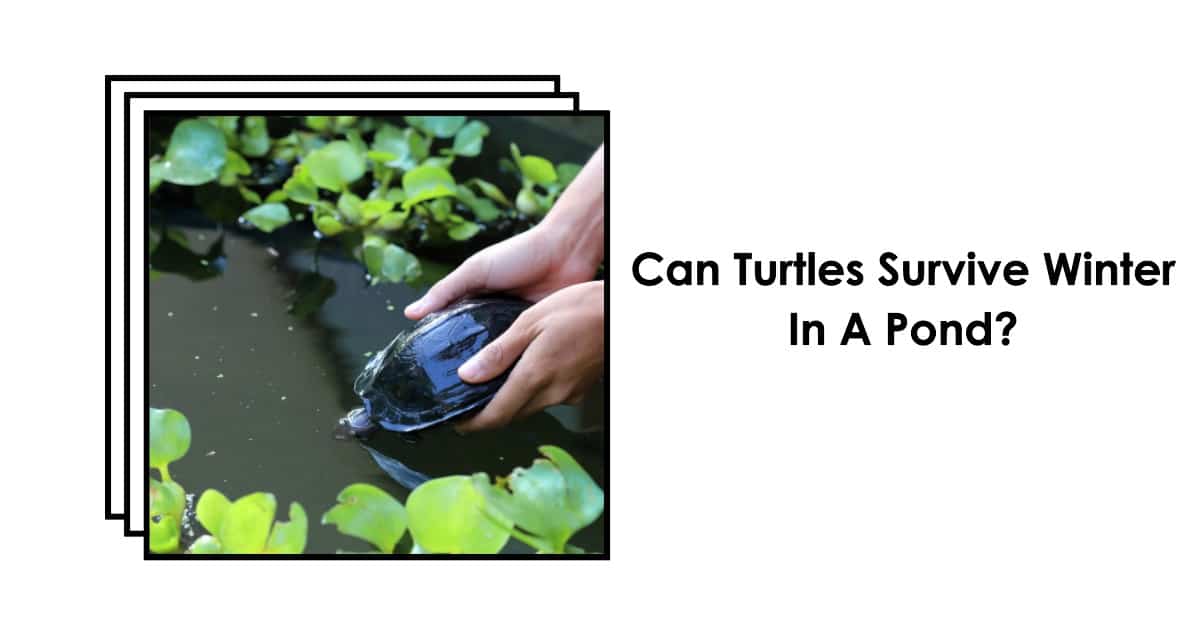Taking care of pet turtles can be both enjoyable and rewarding. However, it pays to understand how best to look after them, so they stay healthy throughout the winter months.
Turtles can live in a pond during winter. However, the type of turtle and the environment of the pond will affect their survivability.
Turtles that are native to cold climates, such as painted or snapping turtles, can usually survive winters in ponds without any additional help. These turtles have adapted to the colder temperatures and can hibernate in the mud at the bottom of a pond. They may even remain active on warmer days throughout winter.
In this guide, you’ll learn if your turtle is able to survive some cold weather or not – plus ways you can create an ideal pond environment for them during these challenging times.
Key Takeaways:
- Turtles that are native to cold climates can usually survive winters in ponds without any additional help.
- The environment of the pond will affect turtles’ survivability during winter.
- Ideal water depth for overwintering turtles is 60-90cm (2-3ft) and the recommended pH is between 6.5-7.5.
- Turtles go into brumation, a state of lessened activity and metabolic rate during winter months to conserve energy.
- Turtles possess a unique ability known as cutaneous respiration which means they can absorb oxygen directly from the water through their skin.
- Certain freshwater turtles may prefer alternative options such as suspending themselves above muck on lake beds during the winter.
Here’s a helpful table with some relevant stats:
| Statistic | Value |
| Average winter temperature for turtles | Between 4-10°C (39-50°F) |
| Ideal water depth for overwintering turtles | 60-90cm (2-3ft) |
| Hibernation period for turtles | 2-4 months |
| Breathing frequency during hibernation | Once every few hours |
| Recommended water quality parameters | pH between 6.5-7.5, dissolved oxygen levels above 5mg/L |
| Best time to prepare pond for winter | Late summer to early fall |
| Food requirements during winter | Minimal to none, as turtles will not be actively feeding |
| Risks of keeping turtles in outdoor ponds during winter | Potential for oxygen depletion, accumulation of harmful toxins, and death due to freezing |
| Recommended precautions | Use pond heaters, aerators, and thermometers to monitor and maintain water temperature and quality. Provide a basking area for turtles to exit the water and warm up in the sun. |
| Common turtle species that can overwinter in outdoor ponds | Red-eared slider, painted turtle, snapping turtle, musk turtle, and box turtle (depending on location) |
Do Pond Turtles Brumate?
Yes, many species of pond turtles do indeed brumate! However, it is crucial to take into consideration the varying specifics that come along with each individual turtle.
First and foremost, let’s start with what brumation actually means. It’s the reptilian version of hibernation – a time of lessened activity and metabolic rate during winter months.
Now, why do these cute little shelled creatures enter such a state? In their natural habitats where temperatures can plummet during winter months, they conserve energy by slowing down in hopes to survive the colder climate.
When does it all go down exactly you ask? Well, timing and duration depend on both environmental factors and species-specific behaviors. Generally speaking, however, turtles will typically begin preparations for their brumation periods when the temperature drops in the late fall/early winter seasons.
So now that we know why our sleepy friends act this way via nature’s survival instinct kicks in…where exactly are they burying themselves? Typically found at or near the bottom substrate layers within enclosures/ponds or nestled inside burrow shelters.
During this phase, our sleepy little chaps won’t eat or drink until temperatures return favorable again.
It’s important owners remember that even though pond turtles are equipped to handle long stretches of limited movement/activity; continued attention must be paid to them so they make it through safe and sound!
Lastly, once spring temps make an appearance, expect sluggish shell-waddles as part of a transitioning period back towards full regular daily activity- potentially taking several weeks before fully energized again!
How Do Turtles Breathe Underwater in The Winter?
Turtles possess a unique ability known as cutaneous respiration – which means they can absorb oxygen directly from the water through their skin. Pretty cool stuff if you ask me!
But wait…there’s more! During winter when ponds freeze over or become covered with ice (which can limit or even prevent oxygen flow), some species such as the Eastern painted turtle have adapted incredible survival techniques. They actually burrow down into soft substrates like mud at the bottom of ponds where gases are still able to pass between the surface and water below.
These remarkable little guys also seem able to tolerate increased amounts of carbon dioxide build-up within this microenvironment they’ve created for themselves!
Now let’s take it one step further: certain freshwater turtles such as snapping turtles and musk turtles may prefer alternative options altogether- opting often just simply suspending themselves above muck on lake beds; raiding whatever pockets of oxygen-rich air trapped beneath thin sheets of ice coverings- holding out until spring temperatures stabilize again.
It’s really quite amazing what our friends in nature are capable of achieving, isn’t it? The key takeaway here is just how resourceful and resilient pond turtles can be when faced with less-than-hospitable environmental conditions.
How Long Can Baby Turtles Live in Cold Water?
Have you heard of overwintering? What exactly does that mean? Well, my friends, it refers to when baby turtles are born in late fall and choose to stay put in their cozy nests until the following spring season – which can be up to a year after their eggs were laid.
Sound like they might get hungry during all that downtime? But guess what folks? These clever critters have learned how to survive without food for long stretches thanks to some pretty awesome biological adaptations. Some of these amazing abilities include:
- Higher body fat and oil levels (which act as fuel reserves)
- Freezing of body fluids without harm
- Or even making use of antifreeze-like chemicals!
It’s important to note that this overwintering phenomenon is observed throughout many different species living in ponds worldwide. These cute little tough-guys aren’t too picky whether one resides amongst salt mashes along coasts, freshwater creeks through forests; streams running between prairies, or chill air mountainsides…these plucky waddlers just find ways to adapt!
Also Read: How Long Can a Turtle Survive without Food?
How To Setup Your Turtle Pond For Winter?
Here I will guide you through some essential steps for preparing your turtle pond for the winter season. So grab a cup of tea and let’s dive in!
Step 1: Clean Your Pond
First things first, it’s time to get down and dirty with some cleaning! Clearing out any debris, fallen leaves or excess algae is crucial to keep your pond pristine – which also prevents toxic gas buildup that could harm our little-shelled sweethearts.
Step 2: Reduce Feeding
As we say goodbye to sunshine-filled days of warmer temps…we welcome cooler weather signaling reduced activity levels – this means less food required by resident turtles! Start reducing their feeding schedule, keeping tabs as temperature drops below 50°F (10°C).
Step 3: Install a Pond Heater
A proper pond heater will help regulate water temperatures during those long chilly months ahead. By maintaining safe above-freezing temps at all times ensures that our little ones remain happy & healthy during their restful state.
Also Read: Do Turtles Need a Heat Lamp?
Step 4: Provide a Basking Spot
Just because the weather outside is turning gloomy does not mean that our aquatic friends don’t still need a place to soak up cheeriness from sun rays when they do happen. Setting up a specific spot where light can reach them while remaining dry and away from debris helps keep them comfortable throughout winter.
Step 5: Add Aquatic Plants
Adding plants into the pond; adds beauty but has other benefits also including using sunlight/CO2 so oxygen accumulates pool water rather than becoming depleted- provides an additional natural source of nutrition too!
Step 6: Cover Your Pond
We need cover for Ponds… In colder seasons not only creates A barrier against unwanted debris and keeps heat insulated which minimizes animals; predators naturally recognize the absence of prey on suitable surface domain.
With these simple tips/checklists provided above followed closely, you’ll have peace-of-mind knowing that your shelled compatriots are well taken care of and happy as can be throughout the chilly winter months.
Frequently Asked Questions
Where Do Outdoor Turtles Live in Winter?
Some outdoor turtles are absolute pros at hibernation; they’ll tuck themselves away into ponds or watery hideaways until springtime rolls back around. Others prefer to snuggle up in cozy burrows lined with soil or leaves, catching some zzz’s until the weather warms up.
On the flip side, if you live somewhere with milder winters (lucky you!), there are species of turtles that might stay active year-round. Outdoor turtles have adapted plenty of strategies to ensure a happy hibernation (or non-hibernation!) season.
Can Turtles Really Breathe Through Their Butts?
Yes, you read that right, turtles can get oxygen through their butts. These little reptiles have a specialized organ called the cloaca that allows them to absorb oxygen from the water and release carbon dioxide.
This process of cutaneous respiration is not only impressive, but it also helps turtles conserve energy while they’re underwater. They can stay submerged for longer periods without having to come up for air as often as other animals might.
How Do Turtles Stay Warm in Cold Water?
Turtles have adapted to stay warm in cold water through a process called brumation. Brumation is similar to hibernation, but it occurs during the winter months when the water temperature drops. During this period, turtles will slow down their metabolism and become less active. This helps them conserve energy and stay warm in the cold water.
Conclusion
The question of whether turtles can chill in a pond during the winter months depends on a few key factors – like which species of turtle is involved, how deep the pond is, and just how harsh the winter actually turns out to be.
Now before you start fretting and tossing away your turtle dreams for good, take comfort in knowing that with proper care and attention, it is possible for these resilient little creatures to survive even the coldest of seasons.
Turtles have successfully adapted themselves to thrive across multiple environments over time- including even hibernating when needed in order to conserve energy throughout those frigid winter months.
So don’t give up hope just yet if what you’ve got your heart set on is creating a welcoming sanctuary within your pond home for some shelled friends this season… with some quick research and advanced preparation beforehand, yours might just become the hot spot destination after all!







